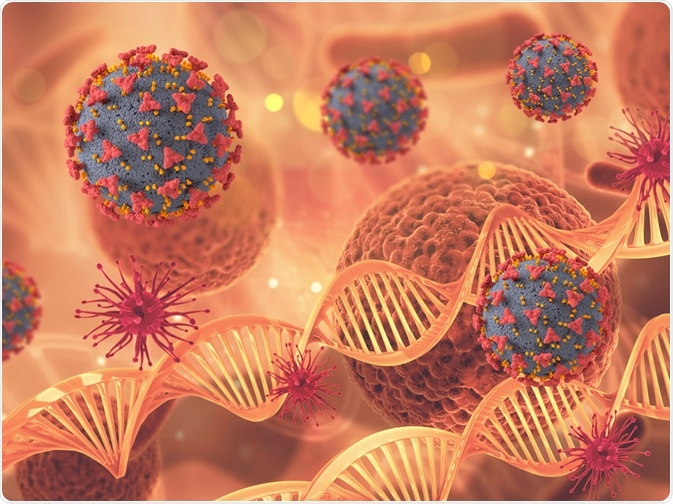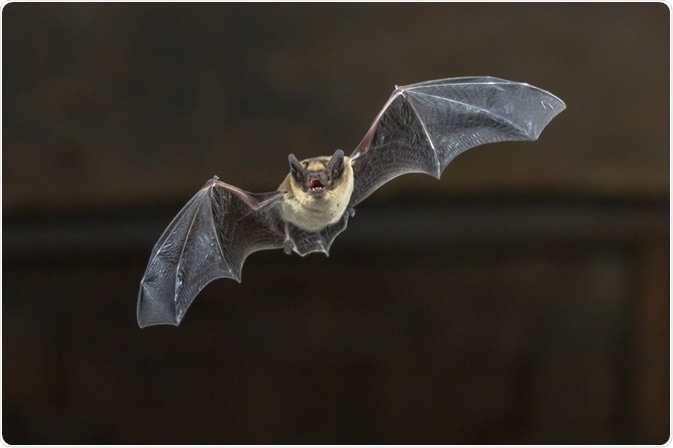Viruses can occasionally, but quite rarely, move from one species to another. This is called a spillover event but can also be known as a spillover infection or a pathogen spillover. A spillover event is what led the causative virus of COVID-19, severe acute respiratory syndrome coronavirus 2 (SARS-CoV-2), to transmit from bats to humans.

Image Credit: Kjpargeter/Shutterstock.com
The process of a spillover event
Spillover events involve a virus overcoming several barriers to become feasible in another species. Most spillover events follow the same process. The virus should not be too effective in its primary host species, to prevent ruining the species viability, and this species acts as a reservoir for the virus.
The transmission requires close contact between the primary host species and the secondary host species. The transmission also requires the virus to break through the barriers that would typically prevent spillover events – this includes circumventing the inherent incompatibility between the virus and its new species and overcoming the new host’s immune response.
Following the successful transmission from one host species to another, the virus must also have successful transmission within members of its new secondary host. During this process, the virus attains an increased disease incidence and new hosts are infected at an increasing rate.
Chances of a spillover event
Spillover events are very rare, but the chances of them occurring can differ between viruses and hosts. This includes how often the secondary host interacts with the primary host species, connectivity between populations, and population density.
In general, the chances of a spillover event occurring can be divided into three main categories: pathogen pressure, human and vector behavior, and attributes of the host. All of these phases are accompanied by significant barriers to spillover events occurring, which the virus must overcome.
Pathogen pressure refers to the amount of pathogen that is exposed to the new host at any given point in time and space. This depends on the pathogen’s prevalence and releases from the reservoir host and its subsequent survival and dissemination in the new host.
For example, it is believed that the lack of spillover events of monkeypox to humans in the west Democratic Republic of Congo can be attributed to cultural norms, which avoid the consumption of squirrels.
Human and vector behavior can affect the chances of a spillover event based on the exposure to the pathogen, such as time spent near the reservoir host species. This is accompanied by the likelihood, route, and dose of exposure.
The attributes of the host then affect the probability of spread within the new species and the severity of the infection. This is determined by genetic, physiological, and immunological attributes of the host, and the dose and route of exposure the virus takes.
Coronaviruses have overcome many of the natural barriers that usually stop spillover events from occurring. They are RNA viruses, which can evolve quicker than other virus families because of their ability to recombine and acquire point mutations.
How do viruses jump from animals to humans? - Ben Longdon
Examples of spillover events
One of the most famous and common examples of spillover events is the flu. Migratory birds are an original reservoir of the influenza virus, with spillover events affecting other birds, pigs, and humans. However, humans are now also a primary reservoir host species of influenza A.
In addition to birds, bats are a relatively common source of spillover events. For example, the Ebola virus originated in bats. Most researchers think that and the causative virus of COVID-19 also came from bats, although it is still unknown if there was an intermediate species. Spillover events from wild animals can be more complex to track, both to find the original reservoir host species and to understand the factors influencing a spillover event.
Interestingly, a study from September of 2019 looked at the spillover of SARS-CoV to humans from bats in China. This study did not find a direct relationship between contact with bars and coronavirus occurring in humans but did find that frequent contact with domestic animals and livestock was common in communities where coronavirus was occurring.
This indicated that there was an alternative spillover pathway, with indirect exposure to bat coronaviruses. However, the study also found that this was a very rare event.
While spillover events to humans receive most of the attention, spillover events can also occur between animal species.
For example, the porcine epidemic diarrhea virus (PEDV) is believed to have had its spillover event from its original bat reservoir to pigs. In piglets, its mortality rates range from 10% to 100% and therefore it has a huge impact on the agriculture industry.

Image Credit: Rudmer Zwerver/Shutterstock.com
References
- Ohio State Insights. 2020. "Spillover" Events Like The Coronavirus Have Happened Before. How Do We Stop Them?. [online] Available at: <https://insights.osu.edu/food/coronavirus-spillover>
- Plowright, R., Parrish, C., McCallum, H., Hudson, P., Ko, A., Graham, A., and Lloyd-Smith, J., 2017. Pathways to zoonotic spillover. Nature Reviews Microbiology, 15(8), pp.502-510.
- Li, H., Mendelsohn, E., Zong, C., Zhang, W., Hagan, E., Wang, N., Li, S., Yan, H., Huang, H., Zhu, G., Ross, N., Chmura, A., Terry, P., Fielder, M., Miller, M., Shi, Z. and Daszak, P., 2019. Human-animal interactions and bat coronavirus spillover potential among rural residents in Southern China. Biosafety and Health, 1(2), pp.84-90.
Further Reading
Last Updated: Mar 2, 2021